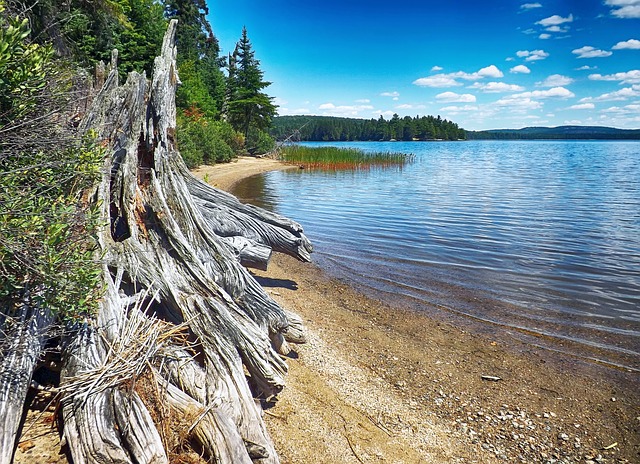Even people who live in Ontario can have trouble appreciating the sheer size of this province. Ontario is Canada’s second largest province, covering more than 1,000,000 square kilometres (415,000 square miles) – an area larger than France and Spain combined.
If you look at a map of Ontario you will notice that the province is bounded by Quebec on the east, Manitoba on the west, Hudson Bay and James Bay on the north, and the St. Lawrence River and the Great Lakes on the south.
The longest east-west distance in Ontario is 1,690km (1050mi). The longest north-south distance is 1,730km (1075mi). The highest point is 693m (785yards) above sea level, in the Timiskaming area.
Manitoulin Island in Georgian Bay is the world’s largest freshwater island covering 2,766 square kilometres (1,068 square miles).
Sault Ste. Marie is the Ontario city located closest to the halfway point of the Trans-Canada Highway that runs from Victoria, British Columbia to St. John’s, Newfoundland.
Ontario is home to more than one time zone. The boundary line between the Central Time Zone and Eastern Time Zone is just west of Thunder Bay running north from the United States border to Hudson Bay.
Ontario’s most northerly communities are close to the same latitude as London, England and Warsaw, Poland. Ontario’s southernmost point of land is Middle Island, in Lake Erie south of Point Pelee, roughly parallel to Barcelona, Spain or Rome, Italy.
More than 13 million people live in Ontario.
PHYSICAL GEOGRAPHY
The province of Ontario consists of three main geographical regions:
- The thinly populated Canadian Shield in the northwestern and central portions which covers over half the land area in the province; though mostly infertile land, it is rich in minerals and studded with lakes and rivers. Northern Ontario is subdivided into two sub-regions: Northwestern Ontario and Northeastern Ontario.
- The virtually unpopulated Hudson Bay Lowlands in the extreme north and northeast, mainly swampy and sparsely forested.
- The temperate and therefore most populous region, the fertile Great Lakes-Saint Lawrence Valley in the south where agriculture and industry are concentrated. Southern Ontario is further sub-divided into four regions; Central Ontario (although not actually the province’s geographic centre), Eastern Ontario, Golden Horseshoe and Southwestern Ontario (parts of which were formerly referred to as Western Ontario).
Despite the absence of any mountainous terrain in the province, there are large areas of uplands, particularly within the Canadian Shield which traverses the province from northwest to southeast and also above the Niagara Escarpment which crosses the south. The highest point is Ishpatina Ridge at 693m (2,274ft) above sea level located in Temagami, Northeastern Ontario. In the south, elevations of over 500m (1,640.42ft) are surpassed near Collingwood, above the Blue Mountains in the Dundalk Highlands and in hilltops near the Madawaska River in Renfrew County.
Niagara Escarpment
The Carolinian forest zone covers most of the southwestern section, its northern extent is part of the Greater Toronto Area at the western end of Lake Ontario. The most well-known geographic feature is Niagara Falls, part of the much more extensive Niagara Escarpment. The Saint Lawrence Seaway allows navigation to and from the Atlantic Ocean as far inland as Thunder Bay in Northwestern Ontario. Northern Ontario occupies roughly 87% of the surface area of the province; conversely Southern Ontario contains 94% of the population.
The Niagara Escarpment is a long escarpment in the United States and Canada that runs westward from New York State, through Ontario, Michigan, Wisconsin and Illinois. It is composed of the Lockport geological formation of Silurian age, and is similar to the Onondaga geological formation, which runs parallel to it and just to the south, through the western portion of New York and southern Ontario. The escarpment is most famous as the cliff over which the Niagara River plunges to form Niagara Falls, for which it is named.
The Niagara Escarpment is the most prominent of several escarpments formed in the bedrock of the Great Lakes. Niagara River forming a deep gorge north of Niagara Falls, which itself cascades over the escarpment. In Southern Ontario it stretches along the Niagara Peninsula hugging close to the Lake Ontario shore near the cities of St. Catharines, Hamilton and Milton where it takes a sharp turn north in the town of Dundas toward Georgian Bay. It then follows the Georgian Bay shore northwestwards to form the spine of the Bruce Peninsula, Manitoulin, St. Joseph Island and other islands located in northern Lake Huron where it turns westwards into the Upper Peninsula of northern Michigan, south of Sault Ste. Marie. It then extends southwards into Wisconsin following the Door Peninsula and then more inland from the western coast of Lake Michigan and Milwaukee ending northwest of Chicago near the Wisconsin-Illinois border.
In February 1990, the Niagara Escarpment was designated a World Biosphere Reserve by UNESCO, making it one of twelve in Canada. Development and land use on and adjacent to the physical escarpment is regulated by the Niagara Escarpment Commission, an agency of the Ontario government.
CLIMATE
Ontario has three main climatic regions. Parts of Southwestern Ontario have a moderate humid continental climate. The region has warm, humid summers and cold winters. Annual precipitation ranges from 75–100cm (30–39in) and is well distributed throughout the year with a usual summer peak. Most of this region lies in the lee of the Great Lakes making for abundant snow in some areas. Point Pelee and Middle Island, the southernmost parts of the country, are at the dividing line of a humid continental climate and a humid subtropical climate.
Central and Eastern Ontario have a more severe humid continental climate. This region has warm and sometimes hot summers with colder longer winters, with ample snowfall and roughly equal annual precipitation as the rest of Southern Ontario. Along the eastern shores of Lake Superior and Lake Huron, frequent heavy lake-effect snow squalls increase seasonal snowfall totals upwards of 3m (120in) in some places.
The northernmost parts of Ontario — primarily north of 50N have a subarctic climate with long, severely cold winters and short, cool to warm summers with dramatic temperature changes possible in all seasons. With no major mountain ranges blocking sinking Arctic air masses, temperatures of −40°C (−40.0°F) are not uncommon, snowfall remains on the ground for sometimes over half a year. Precipitation is generally less than 70cm (28in).
Severe and non-severe thunderstorms peak in summer. London, situated in Southern (Southwestern) Ontario, has the most lightning strikes per year in Canada, averaging 34 days of thunderstorm activity per year. In a typical year, Ontario averages 15 confirmed tornado touchdowns, though they are rarely destructive (the majority between F0 to F2 on the Fujita scale). Tropical depression remnants occasionally bring heavy rains and winds in the south, but are rarely deadly. A notable exception was Hurricane Hazel which struck Toronto, in October 1954. Winter storms can disrupt power supply and transportation, severe ice storms can also occur, especially in the east.
ONTARIO’S NATURAL RESOURCES
Water
Ontario’s quarter million lakes and countless rivers and streams played a central role in the province’s history and development. For Aboriginal peoples and the early European settlers, the lakes and rivers were a means of transportation and a source for food. Waterways determined the patterns of settlement as well as the patterns of industrialization.
In the early 20th century, Ontario Hydro began harnessing the awesome power of the Niagara Falls to provide reliable electricity to homes and businesses.
The Great Lakes are one of the world’s most important natural resources
The Great Lakes are Lake Superior, Lake Michigan, Lake Huron, Lake Erie, and Lake Ontario. They hold one-fifth of all the surface fresh water in the world. The combined shoreline of the Great Lakes is equal to about 45% of the earth’s circumference. They are also home to more species than almost anywhere else in Canada – including more than 150 species of fish. Forty million people in two Canadian provinces and eight U.S. states live in the Great Lakes-St. Lawrence River Basin. For centuries, Ontario’s history, economy and way of life have been closely tied to the Great Lakes.
The five Great Lakes, four of which straddle the border between Canada and the United States (U.S.), are the world’s biggest continuous body of fresh water. A Canada/U.S. commission jointly manages the Great Lakes. The Great Lakes Basin covers an area of 750,000 square kilometres; this basin includes eight U.S. states, most of southern Ontario and extends into northern Ontario.
More than 98% of Ontario residents – 13 million people – live within the Great Lakes Basin. Most live near the shores, in eight of Canada’s 20 largest cities, which include Toronto, Hamilton, Windsor and Sarnia. The people of Ontario depend on the Great Lakes for their drinking water. Over 70%, or three out of four residents, get their drinking water from the lakes.
The Great Lakes support more than half of Canada’s manufacturing output, a quarter of the country’s agriculture and $300 billion annually in trade between Ontario and the U.S. The lakes sustain a $100 million commercial fishing industry and a $350 million recreational fishing industry and every year 1.5 million recreational boaters enjoy the Great Lakes.
Forests
Ontario’s landscape is dominated by forests. We have over 71 million hectares of forest and about 85 billion trees. Hardwood species such as maple and oak forests are found in the south, while conifer species such as jack pine and spruce forests dominate the north. Our forests cover a land area equivalent in size to the landmasses of Germany, Italy and the Netherlands combined.
There are four forest regions in Ontario:
- Hudson bay lowlands (subarctic barrens) – contains 19% of Ontario’s forests
- boreal forest, the largest forest region in Ontario and Canada – contains 58% of Ontario’s forests
- Great Lakes-St. Lawrence – contains 19% of Ontario’s forests
- deciduous forest (Southern Ontario) – contains 3% of Ontario’s forests
Quick Facts
- Ontario has approximately 85 billion trees
- 66.0% of Ontario is forest (71.1 million ha)
- 80.8% of Ontario’s forests are on Crown forest (public forest lands) (57.5 million ha)
- 9.0% of Ontario’s forests are within existing and proposed Parks and Protected areas (6.4 million ha)
- 51.6% of the forest in the boreal region are managed by the Crown
- 44.2% of the forest in the boreal is unavailable for harvest
- Less than one-half of 1% of the forest in the boreal region is harvested annually
- The average age of Area of the Undertaking (AOU) forests have increased from 73 years old in 1996, to 79 in 2001 and 82 years old in 2006 and remained at 83 years old in 2011
- 55.8% of the AOU is softwood or coniferous forest types
- 25.5% of the AOU is hardwood or deciduous forest types
- 18.7% of the AOU is mixedwood forest types
- Ontario’s most common tree is the black spruce (37.3% of total provincial growing stock), followed by poplar (20.8%), and jack pine (11.7%)
- The most common provincial forest types are conifer upland and lowland, which are dominated by spruce, and make up 55.3% of the boreal forest
PLANTS AND ANIMALS
Biodiversity is the great variety of living things on earth. Ontario has polar bears and pelicans. Eight kinds of bats and 17 kinds of snakes live here. Cactus grow in our most southern region, and arctic willows grow in the Far North. Our lakes and rivers are home to tiny minnows and sturgeon that grow up to two metres long. About 30,000 species of plants and animals are native to Ontario. That includes:
- more than 80 different mammals
- 400 kinds of bird
- 80 reptiles and amphibians
- 20,000 types of insects, spiders and other invertebrates (animals that don’t have backbones)
- more than 3,300 species of plants
- more than 1,000 types of fungi and algae
Ontario Ministry of Natural Resources staff actively manage Ontario’s fisheries. We monitor fish populations, support projects to improve habitat and stock about eight million fish each year.
Ontario has been blessed with an abundance of natural resources. A wide range of industries make use of these resources. Hunting has been part of life in Ontario for thousands of years. For countless families, it’s an activity and a set of skills passed down from one generation to the next. Today, more than 400,000 Ontarians are hunters. Resource industries create jobs and prosperity, but we must always make sure that these resources will be available for future generations.
MINERAL RESOURCES
Canadian Shield is one of the world’s richest areas in terms of mineral ores. It is filled with substantial deposits of nickel, gold, silver, and copper. Throughout the Shield there are many mining towns extracting these minerals. The largest, and one of the best known, is Sudbury. Sudbury is an exception to the normal process of forming minerals in the Shield since there is significant evidence that the Sudbury Basin is an ancient meteorite impact crater. Ejecta from the meteorite impact was found in the Rove Formation in May 2007. The nearby, but less known Temagami Magnetic Anomaly, has striking similarities to the Sudbury Basin. This suggests it could be a second metal-rich impact crater
Sources:- http://www.mnr.gov.on.ca
- en.wikipedia.org/wiki/Geography_of_Ontario
- en.wikipedia.org/wiki/Ontario
- en.wikipedia.org/wiki/Niagara_Escarpment


















